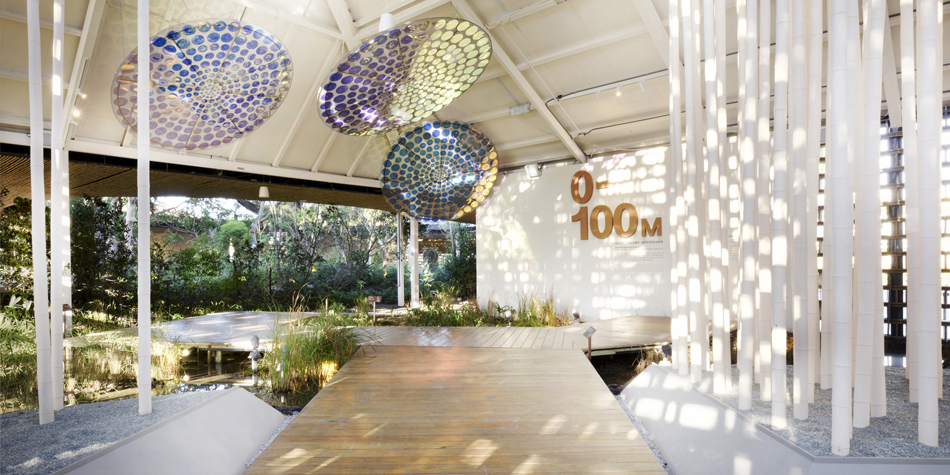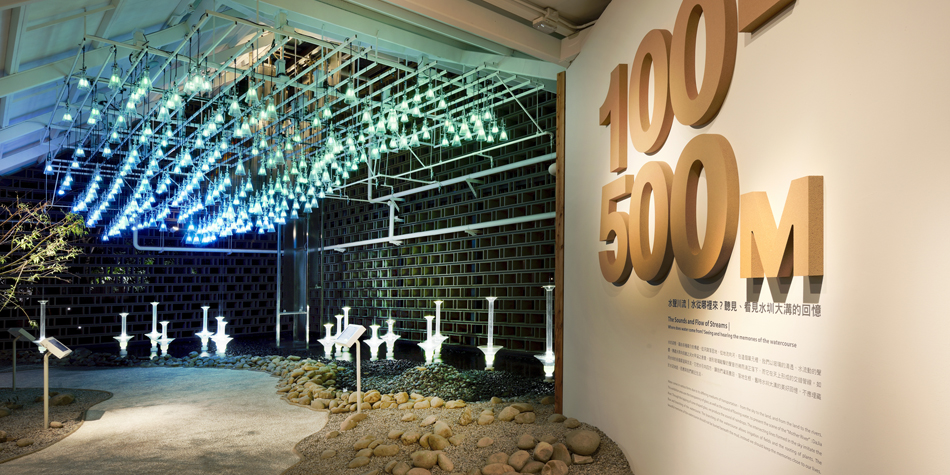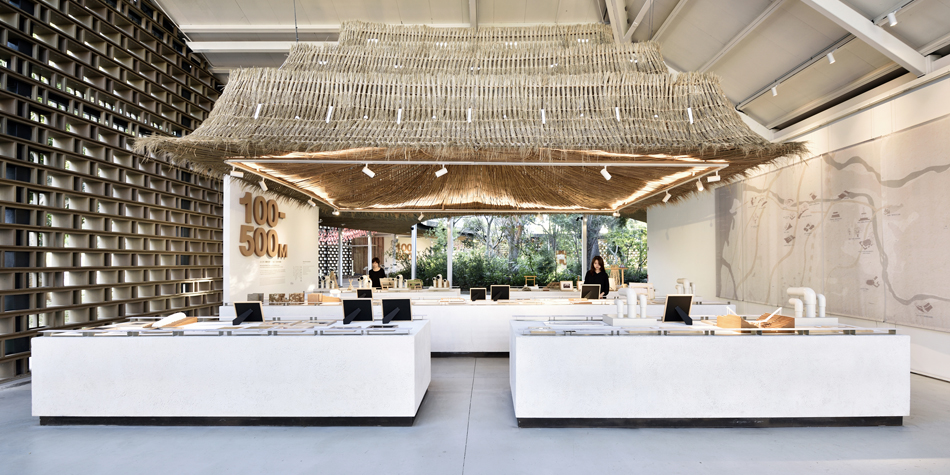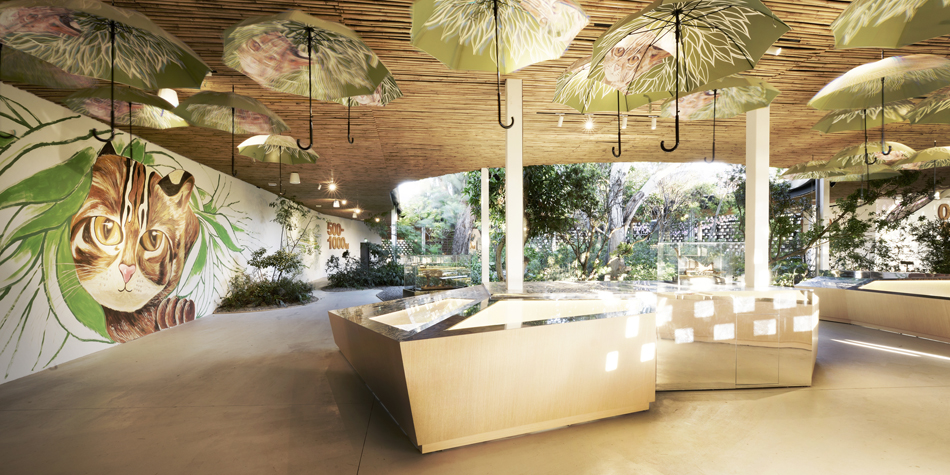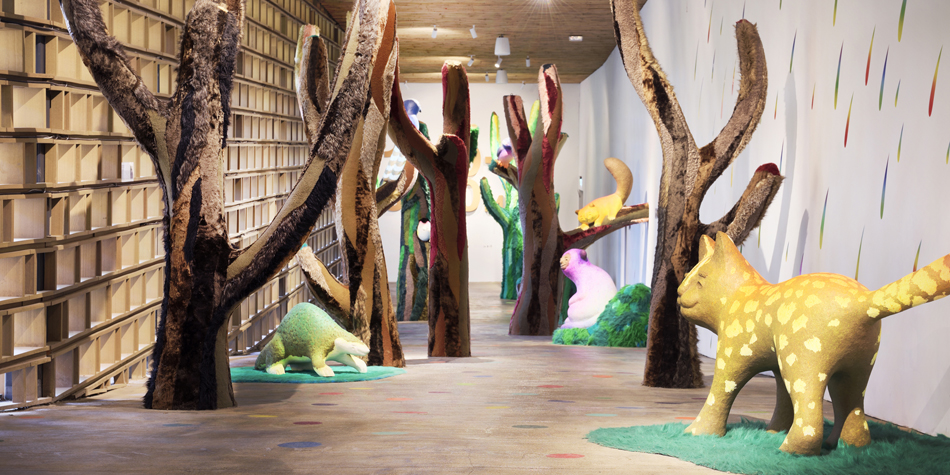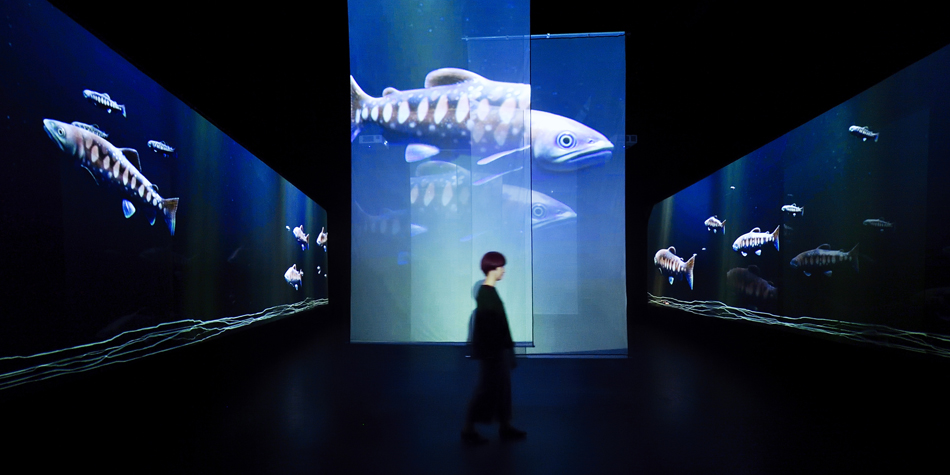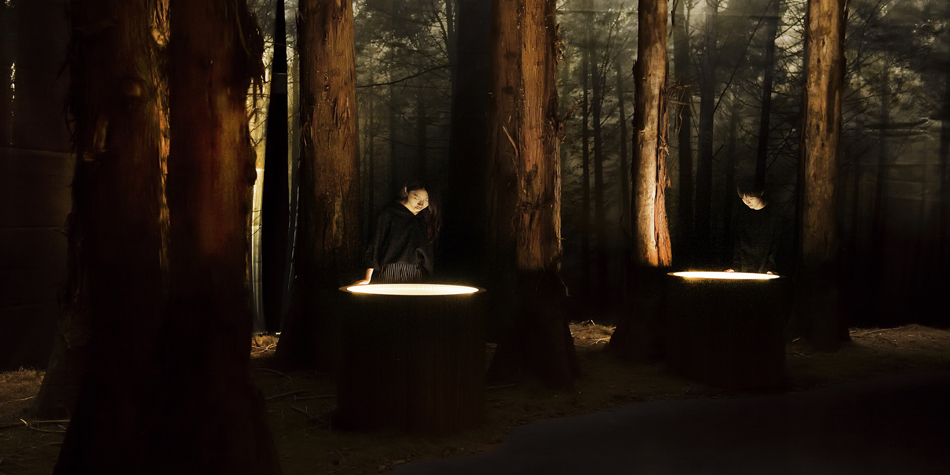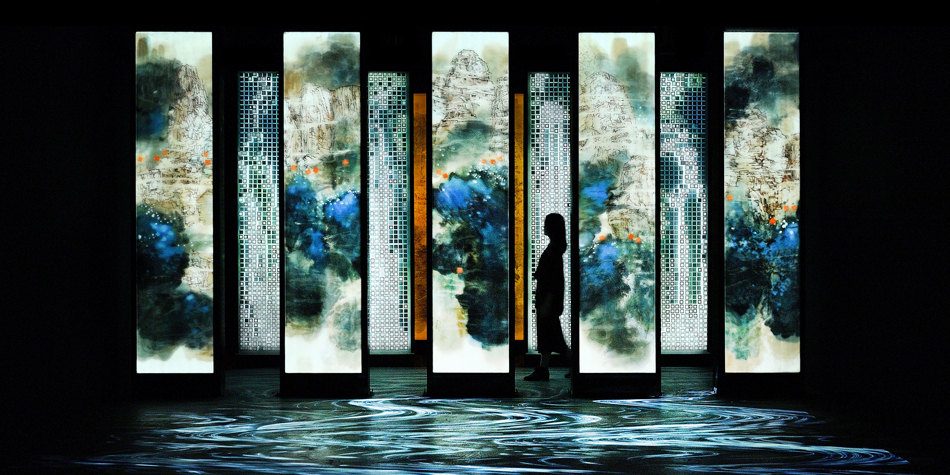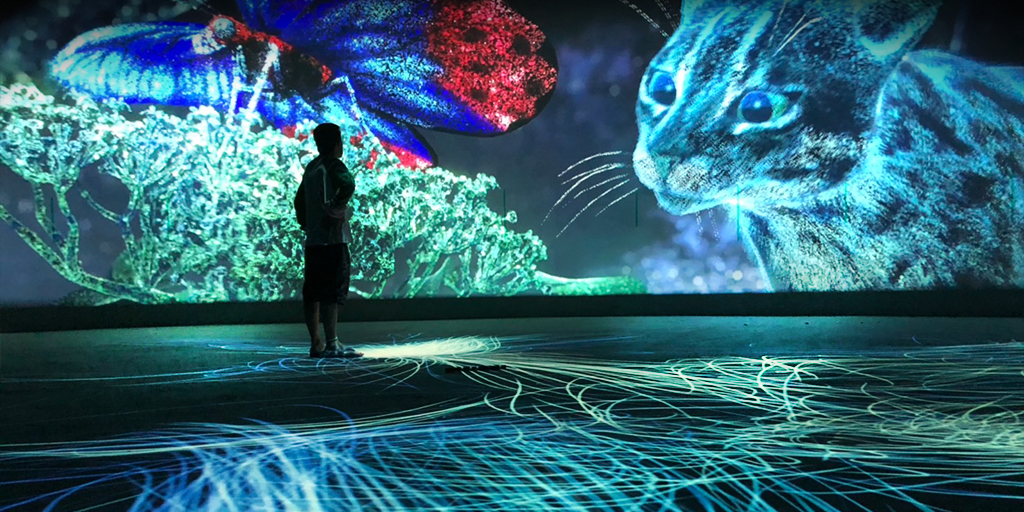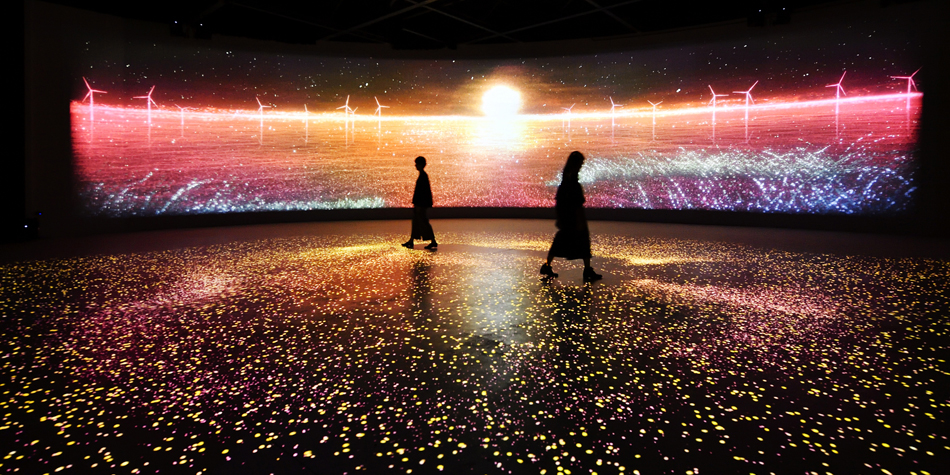Taichung World Flora Expo, Discovery Pavilion
2019 TID Award | Cultural Exhibition Space
2019 Good Design Award Winner
2019 Architecture Masterprize | Honorable Mention in the Interior Design-Exhibition
Using water as a starting point and the lens of the Discovery Pavilion, we walk from the bottom to the top of the Taichung Dajia River landscape. We discover the coexistence of humanity and nature, as well as the ecological variety of Taiwan. Through Taichung’s approach to preserving life in half of our planet, we hope to revive the harmonious balance between humanity and nature.
0-100M
Where the river meets the sea |Humanity and nature join hands in an ecological environment that amazes the world
The vastness of the GaoMei Wetlands, located at the junction between DaJia River and the ocean, presents a world-famous scene where there is seemingly a union between ocean and sky, as well as a dream-like view of the sunset. These wetlands used to be a swimming beach, but the accumulation of sediments at the port of Taichung gave birth to an abundance of life. After Taichung deemed the GaoMei wetlands as a protected nature preserve, the land became enlivened with the flourishing of nearly-extinct Bolboschoenus planieulmisand and Hygrophila pogonocalyx, as well as the multiplying populations of birds, fish, shrimp, and crabs.
100-500M
The sound and flow of streams|Where does water come from? Seeing and hearing the memories of the watercourse
Water comes in various forms due to its differing mediums of transportation – from the sky to the land, and from the land to the rivers. This exhibition area uses the transparency of glass, as well as the sound of flowing water, to present the scene of the “Mother River”: DaJia River. Through the tapping of cone-shaped glass, we produce the sound of raindrops. The intersecting lines formed in the sky imitate the flow and branching of the watercourse. The branching of the watercourse allows irrigation of fields and the rooting of plants. The beautiful memories of the watercourse should not be buried beneath the mud, instead, we should keep the memories close to our lives.
The watercourse acts as a lifeline that extends from the center of the island of Taiwan to its surrounding plains. Land and water create the watercourse, which presents a bridge connecting humans and the river.
In this area of the exhibition, we wove, by hand, a roof made of rice straw that provides shelter from the wind and rain. Rice from these straws has been designed to descend from the ceiling. This demonstrates the story of how our ancestors used their wisdom to create the watercourse from Earth – by borrowing water from land, they were able to provide their people with ample food and clothing. The construction of the watercourse adapts to its ecology by retrieving water from, while returning water back to, the DaJia River. This allows us to see how humanity and nature can coexist in harmony.
500-1000M
Satoyama and Leopard Cats|
Opening an umbrella of protection for our future
Leopard cats are an umbrella species in the Satoyama area. Tiptoeing along with the embrace of Mother Earth, Leopard cats used to cohabitate with humans, but now their population is gradually becoming more and more endangered. Taichung consists of an ecology with high-to-low altitude that is rarely seen, providing a connection to the various habitats of Leopard cats. Because Taichung links the ecological environment of the North and South of Taiwan, it has the important role of preserving these cats.
This area of the exhibition is equipped with pieces of mirrors to reflect the intimate relationship between humanity and nature. Using the mirrors, we hope to display our prior relationship with Leopard cats, as well as to symbolize the brokenness of our present relationship with this species. This allows for the opportunity to further consider the future relationship between humanity and nature. Let us unite in our efforts to open this umbrella of protection to Taiwan’s ecology because we share one community of life with Leopard cats – we have an intimate relationship with these creatures that cannot be replaced.
1000-1500M
Corridors of ecology|Protecting the irreplaceable treasures that are by our side
Walking through narrow trails of the forest, we can touch and feel the thriving atmosphere and appearance of its ecology. In this exhibition area, we begin with the important species of the Leopard cats residing in the low-altitude area of Satoyama. Then, we head towards the enriching animal ecology located in the middle latitudes. The goal is to express an expanding approach to conservation – expanding conservation from Leopards cats to other species. Winding along the corridors, we see familiar animals unique to Taiwan, displayed through vibrant and adorable exhibits surrounding the audience. Created from the combination of paper pulp and fur, these animal statues add a multidimensional appearance for our imagination. The sights produce an atmosphere for both adults and children to experience the feeling of intimacy with an engaging environment.
1500-3500M
Remanence of Ice Age|Re-paving the way for our national treasures of salmon to return home, with not one to lose
Tens of thousands of years ago, glaciers with near one-hundred-meter depths ran through Taichung’s Snow Mountain, creating vast cirques (amphitheater-like valleys formed by glacial erosion) for the Formosan landlocked salmon (Oncorhynchus masou formosanus) to swim from the ocean into the island. Incredibly, these salmon have survived the subtropical climate of Taiwan to this day, becoming the endemic species to Taiwan. From a hundred thousand years ago until now, the valuable, but almost extinct living fossils of the species, came back to life after intensive and persistent conservation efforts.
In this area of the exhibition, we use multi-media designs to create a fantastical underwater site, allowing you to dive to the bottom of Cijia Bay and swim with the national treasures of Formosan landlocked salmon. This conveys the perseverance of life and beauty.
The almighty forest|
Respecting the animals and plants who call nature their home by leaving no trace in the forest
Entering the mountain forests full of towering trees and delicate leaves is like stepping into another world. In this exhibition area, we created a synthetic forest by using ecological forest thinning to obtain Cryptomeria-like Taiwania (Taiwaniacryptomerioides). Through the use of fallen pine needles and temperature changes, the audience experiences the primeval appearance of the magnificent mountains in Taiwan. The spotlights presented in the space allow one to view the native Taiwanese animals amidst the flora and fauna that inhabit the altitudes. The appearance and the movements of life in this area remind people to treat the forest with care and to allow the ecological environment to breathe freely.
0-3886M
A new vision|Rediscovering life in DaJia River and giving back the Half-Earth
The glimmering stars can seem so close, yet so far. They gather and flow around us – who are “they”? “They,” are animals, plants, and thousands of living things.
In this last exhibition area, we use a theater format to interact with the audience. From the viewpoints of indigenous animals, including small egrets, mudskippers, Leopard cats, swallow-tail butterflies, and Formosan landlocked salmons, you see the transformation from the low to the high altitudes of DaJia River. The fine-grained representations and the sense of shock from the vastness of the scene characterizes the perspective that nature is the main character of Taiwan.
As you visit the Discovery Pavilion, we hope to guide you in reconsidering our stunning ecology as the central character of the Earth. Prosperity should not come at the expense of nature – we must rediscover the harmonious balance between humanity and the natural world.





